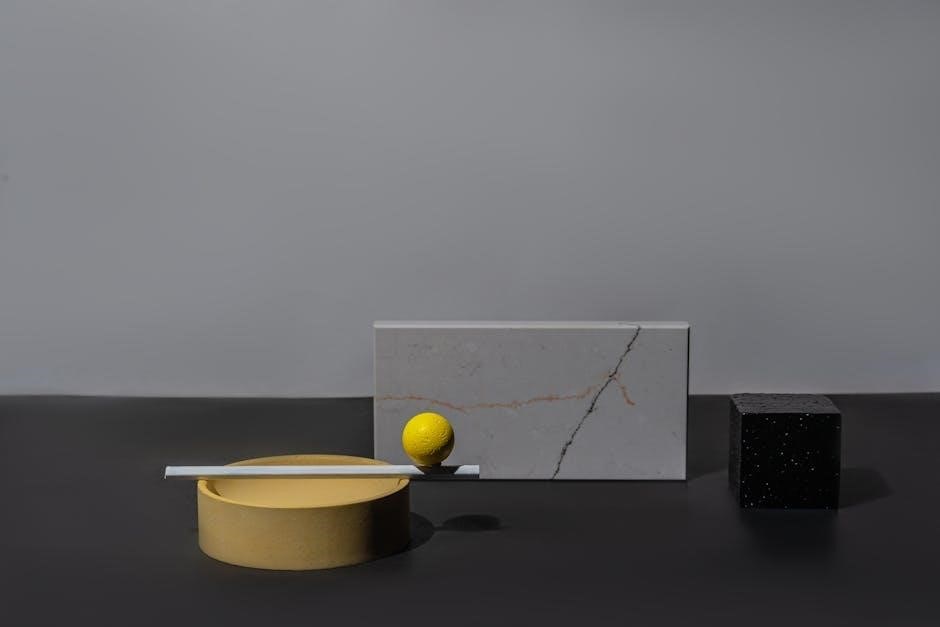Composite Figures Worksheet PDF: A Comprehensive Plan
Exploring composite figure worksheets, particularly those from White Rose Maths, provides valuable practice for KS2 pupils in calculating perimeter and area. Downloadable PDFs offer a 14-page resource!
Composite figures, often encountered in geometry, aren’t your standard shapes like squares or circles. Instead, they’re formed by combining two or more of these basic geometric forms. Think of a house – it’s often a rectangle with a triangular roof! Understanding these shapes is crucial for real-world problem-solving.
Worksheets focusing on composite figures, readily available as PDF downloads (like those from White Rose Maths), are designed to help students develop spatial reasoning and problem-solving skills. These resources bridge the gap between theoretical knowledge and practical application. They encourage students to decompose complex shapes into simpler components.
Initially, students might find these figures challenging, but with consistent practice using targeted worksheets, they’ll gain confidence in identifying the individual shapes and applying the appropriate formulas to calculate area and perimeter. These worksheets are a fantastic starting point for mastering this important geometric concept.
What are Composite Figures?
Composite figures are two-dimensional shapes created by joining together multiple simpler shapes – rectangles, squares, triangles, and even circles. Imagine building with LEGOs; you combine individual bricks to create a larger, more complex structure. Similarly, composite figures are built from basic geometric building blocks.
These figures don’t have a single, straightforward formula for calculating their area or perimeter. Instead, students must decompose the figure, breaking it down into its constituent parts; Worksheets, often available as PDFs, provide visual examples and practice opportunities for this decomposition process.

Resources like those from White Rose Maths specifically target KS2 students, offering exercises focused on rectilinear composite shapes. Understanding this concept is vital as it mirrors real-world scenarios where objects rarely conform to perfect geometric forms. Mastering composite figures builds a strong foundation for more advanced mathematical concepts.
Why Use Worksheets for Composite Figures?
Worksheets dedicated to composite figures are invaluable tools for solidifying student understanding. They provide targeted practice in decomposing complex shapes into manageable components – rectangles, squares, and triangles – a crucial skill for area and perimeter calculations. PDF format offers accessibility and ease of printing for classroom or home use.
Resources like those from White Rose Maths offer a structured approach, progressing from simpler to more challenging problems. This gradual increase in difficulty builds confidence and reinforces learning. Furthermore, worksheets encourage independent practice, allowing students to apply learned concepts at their own pace.
The visual nature of these exercises is particularly beneficial, helping students connect abstract mathematical ideas to concrete representations. Effective worksheets also include answer keys, enabling self-assessment and immediate feedback. Ultimately, consistent worksheet practice fosters fluency and problem-solving skills.

Understanding Perimeter in Composite Shapes
Perimeter calculations for composite shapes involve summing all outer sides. White Rose Maths worksheets focus on rectilinear shapes, aiding pupils in mastering this essential skill.
Defining Perimeter
Perimeter, at its core, represents the total distance around the outside of a two-dimensional shape. Imagine walking along each side of a figure and measuring the total length of your walk – that’s the perimeter! It’s a fundamental concept in geometry, crucial for understanding spatial relationships and solving practical problems.
For simple shapes like rectangles and squares, calculating the perimeter is straightforward: add up the lengths of all four sides. However, composite shapes, formed by combining multiple basic shapes, require a more nuanced approach.
Worksheets, like those offered by White Rose Maths, are instrumental in solidifying this understanding. They present various composite figures, challenging students to identify all the sides and accurately calculate the total perimeter. These resources often focus on KS2 level learning objectives, specifically calculating the perimeter of composite rectilinear shapes. Mastering perimeter is a building block for more advanced geometric concepts, and these worksheets provide targeted practice.
Understanding perimeter isn’t just about formulas; it’s about visualizing and applying geometric principles.
Calculating Perimeter of Rectangles & Squares – A Review
Before tackling composite shapes, a firm grasp of perimeter calculation for basic rectangles and squares is essential. The perimeter of a rectangle is found using the formula: P = 2l + 2w, where ‘l’ is the length and ‘w’ is the width. Simply add the length and width, then multiply the result by two.
For a square, where all sides are equal, the formula simplifies to P = 4s, where ‘s’ is the side length. This is because a square has four equal sides.
Worksheets often begin with these foundational calculations to ensure students are comfortable with the basics. Resources like those from White Rose Maths provide ample practice with individual rectangles and squares, building confidence before introducing more complex scenarios.
These review exercises aren’t merely repetitive; they reinforce the core concept of adding side lengths. This skill is directly transferable to composite figures, where students must identify and sum the lengths of multiple sides from various rectangles and squares combined.
Applying Perimeter to Composite Shapes
Once students confidently calculate perimeter for rectangles and squares, applying this knowledge to composite shapes becomes the next step. The key is to carefully identify all the exterior sides of the composite figure. Unlike finding the area, where internal lines are considered, perimeter focuses solely on the outer boundary.
Worksheets often present these shapes with some side lengths provided, requiring students to deduce missing lengths using their understanding of rectangle and square properties. This involves logical reasoning and problem-solving skills.
Resources like those from White Rose Maths specifically target calculating the perimeter of composite rectilinear shapes. These exercises build upon the foundational skills, encouraging students to break down complex figures into simpler components.
A common mistake is to include internal lines in the perimeter calculation. Emphasize the importance of only adding the lengths of the outer edges. Practice with varied composite shapes is crucial for mastering this concept.

Area in Composite Shapes: The Basics
Understanding area calculation within composite figures requires breaking down the shape into familiar components – rectangles, squares, and triangles – for effective problem-solving.

Defining Area
Area, fundamentally, represents the two-dimensional space enclosed within the boundaries of a shape. It’s not merely the length of the sides, but the amount of surface covered. When working with composite figures, grasping this concept is paramount. Think of it as tiling a floor – you’re calculating how many tiles are needed to completely cover the surface.
Unlike perimeter, which measures the distance around a shape, area is measured in square units – square inches, square feet, square centimeters, and so on. This highlights that area is a two-dimensional measurement.
For composite shapes, directly applying an area formula isn’t usually possible. Instead, the strategy involves decomposing the complex shape into simpler, recognizable forms. Worksheet PDFs, like those offered by resources such as White Rose Maths, often guide students through this decomposition process, providing practice in identifying these basic shapes within more complex designs. Successfully defining area is the first step towards mastering calculations involving these figures.
Calculating Area of Basic Shapes (Rectangle, Square, Triangle)
Before tackling composite figures, a firm grasp of basic area calculations is crucial. For a rectangle, the area is simply length multiplied by width (Area = l x w). A square, being a special type of rectangle, uses the same formula – side multiplied by side (Area = s x s).
Triangles require a slightly different approach. The area of a triangle is calculated as one-half multiplied by the base and the height (Area = 1/2 x b x h). It’s important to remember that the height must be perpendicular to the base.
Composite figures worksheets, such as those available as PDFs, frequently build upon these foundational skills. They present scenarios where students must first identify these basic shapes within the larger composite figure. Then, they apply the appropriate formula to each individual shape, ultimately summing the areas to find the total area of the composite figure. Mastering these basic calculations is essential for success.
Decomposing Composite Figures for Area Calculation
The key to conquering composite figures lies in decomposition – breaking down the complex shape into simpler, recognizable components. Worksheet PDFs often present figures that can be divided into rectangles, squares, and triangles. This process simplifies the area calculation significantly.
Students learn to visually dissect the figure, drawing lines to delineate the individual shapes. Once separated, they apply the area formulas learned previously (length x width for rectangles/squares, 1/2 x base x height for triangles).
Crucially, the total area of the composite figure is found by summing the areas of all its constituent parts. White Rose Maths worksheets, for example, provide ample opportunity to practice this skill. Effective worksheets guide students through this process, building confidence and reinforcing the concept of additive area. This decomposition strategy is fundamental to problem-solving.

Types of Composite Figures & Worksheet Focus
Worksheet PDFs commonly feature figures combining rectangles and squares, alongside those incorporating triangles. Some introduce circles, demanding varied area calculations and problem-solving skills.
Composite Figures with Rectangles and Squares
Worksheets frequently begin with composite shapes constructed from rectangles and squares, serving as a foundational step for students. These figures allow focused practice on applying perimeter and area formulas already familiar from individual shape studies. Typically, students will decompose the complex shape into its rectangular and square components.
Then, they calculate the area or perimeter of each component separately before summing the results to find the total area or perimeter of the composite figure. PDF worksheets often present variations in complexity, starting with simple arrangements and progressing to more intricate designs. These may involve overlapping rectangles or shapes with cut-outs, requiring careful attention to detail.
The focus remains on reinforcing the core concepts of area (length x width) and perimeter (2 x (length + width)) within a more challenging context. White Rose Maths resources, for example, provide targeted exercises to build confidence in these calculations. Answer keys are crucial for self-assessment and identifying areas needing further practice.

Composite Figures with Triangles
Introducing triangles into composite figures elevates the challenge, requiring students to recall and apply the area formula (1/2 * base * height). Worksheet PDFs often combine rectangles or squares with triangular elements, demanding decomposition skills to identify each shape accurately. Students must correctly identify the base and height of each triangle, which may not always be immediately obvious.
These problems frequently involve right-angled triangles, but worksheets may also include scalene or isosceles triangles, adding to the complexity. Calculating the perimeter becomes more nuanced as students need to sum all sides of the composite shape, including the triangle’s sides. Effective worksheets provide diagrams with clear labeling of dimensions.
Resources like those from White Rose Maths offer progressive exercises, starting with simple combinations and gradually increasing difficulty. The inclusion of answer keys allows for independent practice and error analysis. Mastering these concepts builds a strong foundation for tackling more complex geometric problems later on.
Introducing circles into composite figures marks a significant step up in complexity, requiring knowledge of circle-specific formulas – area (πr²) and circumference (2πr). Worksheet PDFs often present scenarios where semicircles or quarter-circles are combined with rectilinear shapes, demanding students to calculate these curved portions accurately.
A key skill is recognizing the radius of the circle within the composite figure, which may be directly given or require deduction from other dimensions. Students need to understand how to calculate the area of a partial circle (e.g., a semicircle is half the area of a full circle). Perimeter calculations now include the arc length of the circle segment.
Initial worksheets typically focus on simpler combinations, like a rectangle with a semicircle attached. Resources should provide clear diagrams and encourage the use of π ≈ 3.14 for practical calculations. Gradually, worksheets can introduce more complex arrangements and require students to apply multiple formulas within a single problem.

Utilizing Composite Figures Worksheet PDFs

PDF worksheets deliver focused practice, offering benefits like easy printing and offline access. White Rose Maths provides free resources, enhancing learning and skill development.
Benefits of PDF Worksheets
PDF format offers a multitude of advantages when it comes to educational resources like composite figures worksheets. Firstly, they are universally accessible; nearly every device – computers, tablets, and smartphones – can open and view a PDF file without requiring specialized software. This ensures that students can access the materials regardless of their technological setup.
Portability is another key benefit. PDFs are easily downloaded and saved, allowing students to work on them offline, during commutes, or in environments with limited internet connectivity. Printing is straightforward, enabling students to engage with the material in a traditional, tactile manner.
Furthermore, PDFs maintain formatting consistency. The layout and appearance of the worksheet will remain the same regardless of the device it’s viewed on, preventing any distortion or misinterpretation of the problems. This is crucial for accurate problem-solving. White Rose Maths leverages this by providing clear, well-formatted worksheets for optimal learning.
Finally, PDFs are generally secure and prevent accidental alterations to the content, ensuring the integrity of the learning material.
Where to Find Free Composite Figures Worksheets (White Rose Maths)
White Rose Maths is a fantastic resource for educators and parents seeking high-quality, free composite figures worksheets. Their website provides a dedicated section for Key Stage 2 (KS2) maths resources, including materials specifically designed to practice calculating the perimeter of composite rectilinear shapes.
Accessing these resources is simple: navigate to the White Rose Maths website and search for “perimeter KS2” or “composite shapes”. You’ll find a selection of worksheets tailored to different skill levels and learning objectives. They offer task-based learning, with Task 1 focusing on foundational perimeter calculations.
Beyond individual worksheets, White Rose Maths also provides accompanying answer sheets, allowing for self-assessment and efficient marking. The materials are designed to align with the national curriculum, ensuring relevance and applicability.
Furthermore, they frequently update their resources, so it’s worth checking back regularly for new additions. The 14-page PDF worksheet, alongside its answer sheet, is a particularly valuable download for comprehensive practice.
Key Features to Look for in a Worksheet (Answer Keys, Variety)
When selecting composite figures worksheets, several key features enhance their effectiveness. Crucially, an answer key is essential for independent practice and quick assessment. This allows students to verify their solutions and identify areas needing improvement without constant teacher intervention.
Variety in question types is also paramount. Worksheets should move beyond simple rectangle and square combinations, incorporating triangles and, eventually, circles to challenge students’ understanding. A good worksheet will present shapes in different orientations and arrangements.
Look for worksheets that gradually increase in difficulty, starting with straightforward decomposition and progressing to more complex scenarios. The White Rose Maths resources exemplify this, offering task-based progression.
Consider worksheets that include real-world application problems, helping students connect the concept to practical situations. A well-designed PDF will offer a mix of visual and word problems, catering to different learning styles.

Advanced Concepts & Worksheet Applications
Worksheet practice extends to real-world scenarios, fostering problem-solving skills with complex shapes. Assessment and practice solidify understanding of composite figures effectively.
Real-World Applications of Composite Figures
Understanding composite figures isn’t just an academic exercise; it’s a skill with numerous practical applications in everyday life. Consider designing a garden – calculating the area of flowerbeds (often irregular shapes) requires breaking them down into composite components. Similarly, when planning a room renovation, determining the amount of flooring needed involves calculating the area of the room, which might be a composite shape.
Architects and engineers frequently utilize these concepts when designing buildings and structures. Even seemingly simple tasks like fencing a yard with varying sections or determining the amount of material needed for a patchwork quilt rely on the principles of composite figures. Worksheets, like those offered by White Rose Maths, help students bridge the gap between abstract concepts and tangible, real-world scenarios. By applying these skills, students develop a stronger grasp of geometry and its relevance beyond the classroom, preparing them for future challenges.
These applications demonstrate the importance of mastering area and perimeter calculations for composite shapes.
Problem-Solving Strategies for Complex Shapes
Tackling complex composite figures requires a systematic approach. The core strategy involves decomposition – breaking down the irregular shape into simpler, recognizable components like rectangles, squares, and triangles. Once identified, calculate the area or perimeter of each individual component; Remember to carefully examine the diagram for missing lengths, which may require additional calculations using known dimensions.
Worksheets, such as those available as PDFs from resources like White Rose Maths, often present problems that necessitate this decomposition process. Students should practice identifying these basic shapes within the larger composite figure. After calculating individual areas or perimeters, sum them to find the total for the entire shape. Developing strong visualization skills is crucial; sketching lines to aid decomposition can be incredibly helpful. Consistent practice with varied worksheet problems builds confidence and problem-solving proficiency.
Mastering these strategies empowers students to confidently approach even the most challenging composite figure problems.
Using Worksheets for Assessment & Practice
Composite figures worksheet PDFs, like those offered by White Rose Maths, are invaluable tools for both formative and summative assessment. Regular practice solidifies understanding of perimeter and area concepts, allowing teachers to identify areas where students struggle. Worksheets provide a standardized format for evaluating student proficiency, offering clear insights into individual and class-wide performance.
The variety of problems within these PDFs – ranging from simple decompositions to more complex shapes – allows for differentiated instruction. Teachers can select problems appropriate for each student’s skill level. Furthermore, the inclusion of answer keys facilitates quick and accurate grading, saving valuable time. Utilizing worksheets as homework assignments reinforces learning outside the classroom.
Consistent use of these resources fosters a deeper comprehension of composite figures and their applications, preparing students for more advanced mathematical concepts;





